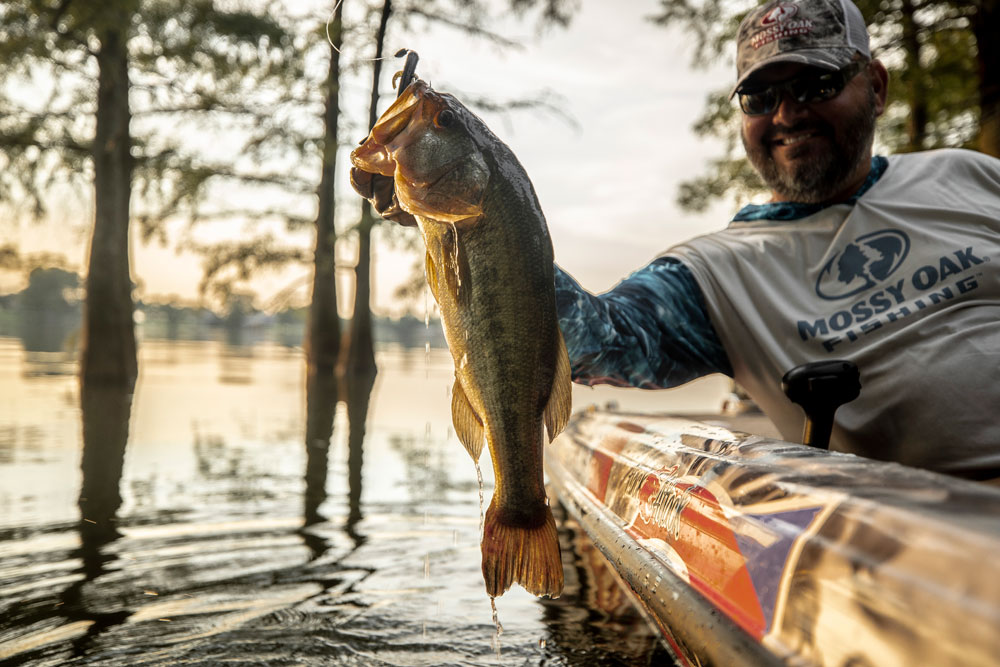Don C. Keller | Originally published in GameKeepers: Farming for Wildlife Magazine. To subscribe, click here.
Creating access to quality fishing is not only rewarding, it's one of the best ways to spend time with family and friends, and introduced future gamekeepers to the outdoors. On this episode of The GameKeepers of Mossy Oak we team up with American Sport Fish and explain how bass spawn and how to create and maintain a healthy fish pond.
Frequently Asked Questions about Largemouth Bass
In the 1970s Don Keller and Barry Smith started American Sport Fish Hatchery in South Alabama. They are considered to be some of the most premier fishery scientist around. When it comes to sport fish management, largemouth bass, trophy bluegill, crappie, they are leaders and pioneers. In this article Don Keller answers some of the more frequently asked questions he receives from lake owners and fisherman.
1. How big does a bass have to be to spawn?
I have seen bass that were 7 inches and fat spawn. Usually bass will spawn when they are one year old and approximately one pound in size in ponds in the south. In reservoirs and streams they may reach 6 to 7 inches at age one and spawn at age two.
2. How many eggs does a female have?
Females may have from 3,000 to 30,000 eggs per pound of body weight. We usually figure about 5-10,000 eggs per pound for production purposes. Also, females usually do not release all their eggs. We have moved females that have already spawned to a new pond and get about 30 to 40 %of the eggs that we got on the first spawn.
3. How long will a bass live?
Bass in cooler areas tend to live longer. The maximum would be 16 to 20 years. The average bass would usually live 5 to 10 years.
4. How fast can a bass grow?
Last May we stocked a lake with 2 inch Tiger Bass finger-lings. We came back to this lake in November and electro-fished the lake and were recovering bass over 2 pounds. We have seen bass that were 7 pounds at age two, 13 pounds at age four and 14 lbs at age 6 ½. Three to four pounds in one year is max.
5. How can I tell a Florida bass from a Northern bass?
You can’t. The only way to tell for sure is by genetic testing. Biologist usually take a fin clip and send it to a lab. Coloration or pigmentation is not a way to tell.
6. Why do bass sometimes appear to be pale in the winter?
The water is usually muddier or stained in the winter. The markings on the bass are determined to some degree by the clarity of the water and the color of the substrate. Clear water allows the light to pass through the pupil of the bass’s eye and strike the pituitary gland. This stimulates the bass to dilate special cells on the skin called melanaphores which contain melan, a black pigment. This reaction makes the blotches or barring on the bass much more distinct.
7. If I catch a bass on a large lake and release it, will it stay close to where I released it?
Yes and no. Maybe. Some bass are “homers” and some are “travelers”. One study found that 90 % of the bass caught, tagged and released were recaptured within 100 yards of the release point. Another study found that over 90% of the bass tagged and released moved a great distance, many traveled up to 16 miles away. This supports what I found in my study on Lake Eufaula. Some bass would be caught by anglers near where we released the fish while others would show up miles away at the other end of the lake.

8. Will a largemouth cross with a smallmouth?
This is very, very rare. When it does happen it is accidental. Keep in mind that they prefer different spawning habitats. The smallmouth prefers deeper rocky areas and the largemouth prefers wind protected coves. The real kicker here is that the bass sperm is only viable for about one minute after it is released by the male so it is unlikely to drift to an unintended partner and fertilize the eggs.
9. Does it hurt the population to catch bass off of the spawning bed?
What difference does it make if you remove a female in February prior to spawning or remove her in April as she is spawning? Spawning bass are not that easy to catch. Most private lakes are under harvested and should have more bass removed so there will be more food available to fatten the remaining bass.
10. Are bass strictly sight feeders?
Bass have senses of sight, smell, hearing and touch. They can pick up vibrations in the water by nerve cells in their lateral line and can pick up higher frequency sounds by their inner ear or otolith. This allows them to feed in muddy water and at night. Bass can smell and taste. We train our bass at American Sport Fish Hatchery to eat a pelleted salmon diet by first getting them to eat krill which they can smell and taste. We then transition them to a feed that has a high content of fish meal which they can detect. They won’t eat catfish food which has a lot of soy-bean meal.
11. If a Tiger Bass (F1) is a cross between a Northern Bass and a Florida Bass, what will the offspring be like?
A sample of young bass collected from a lake that had been stocked for 8 years was taken to Auburn University for genetic testing. Test revealed that the successive generations were almost identical to the original stocked Tiger Bass (F1) strain.
12. Where do bass spawn?
Bass in general spawn in shallower water. We've seen them in water that's a foot deep. They also bed in similar areas as bluegill do but they don't use the same beds, they make their own, and they don't stay as close together like bluegill do, they're going to be more solitary.
13. How many times a year does a bass spawn?
The female will leave the bed, and the male will basically guard the eggs until they hatch. The male can spawn again. The female doesn't drop all of our eggs each time she spawns, she'll drop some eggs that are ready, and then get some more ready and drop some more so female can spawn two or three times.
14. How many bass types are there?
So there are three strains of largemouth bass that are stocked throughout the southeast. There's the northern strain which tends to be more aggressive. They don't grow as large but that aggressive nature really helps catch rates and so a lot of people stock them for that reason. The Florida bass is more aligned with trophy size fish because they grow the biggest. The big negative on Florida bass is when they get larger they get harder to catch on artificial baits. That decline in catch rate has really led to people trying to figure out a way to grow big bass and still keep it aggressive. That's where the F1 came about, and the F1 is a cross between a northern strain and a Florida a strain bass and so that F1 tends to be a little more aggressive than the parents. It gets its aggressive nature from the northern obviously, it also shows hybrid vigor, which means it grows a little faster during the first couple years than both parents, so that benefit really helps, especially if you're trying to grow trophy bass.
15. When do bass spawn?
The main thing that triggers spawning is going to be water temperature and the coming season, so photo period is important as well so the amount of daylight. With bass in our area, March, April, May is our spawning season because of the amount of daylight that's occurring and then also the water temperature. When the water temperature is hitting the mid-60s is normally when the best start spawning.
16. How old does a bass have to be to spawn?
In our area it seems to be about eight inches or so before a bass will spawn. So a year old is roughly the size when a bass spawns. At eight to 10 inches we see pretty good eggs and pretty good milt production. We have seen some that are six to seven inches, they're a little small but they are mature. I would say anywhere from six to 10 inches, so fingerling we spawn this year, next year will spawn.




























